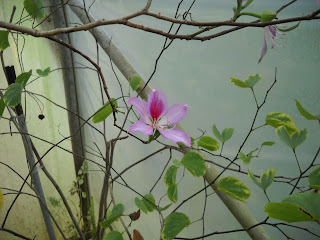I purchased this red Nun Orchid a few weeks ago, and it has endured the conditions of sitting on the porch in hot and chilly without much fussing. When the temperature dropped into the 30's I brought it into the house for the night or til it warmed a bit. I had a couple buds drop from the shorter bloom stalk, but I think that may have been in part because this plant produced 2 stalks from the same pseudobulb which may have been a bit too taxing. Before I saw this one (red) I thought Nun Orchids (Phaius grandifolius) only came in the colors shown below- brown petals with white backs and maroon throats.
I have been growing this Nun Orchid for several years and find it easy cared for and blooming without fuss every spring. It is a terrestrial orchid which means you can grow it in regular potting soil, although like most orchids it needs good drainage. This translates to good potting soil-not that cheap stuff that packs down and becomes like a rock in the pot. But I digress.
Since it is a tall plant , bloom stalks can be three feet tall, you need about a 2 gallon pot if the plant is very big at all. Otherwise the bloom stalk will cause the pot to tip over. Someone in Auburn told me they grew this plant outside, but the range as listed online suggest Zone 9 is as cold as it can take.
This is a stately plant, reliable and easy to care for. If you think you can't grow orchids, you should give this one a try.
This is a stately plant, reliable and easy to care for. If you think you can't grow orchids, you should give this one a try.





.jpg)


.jpg)


.jpg)
